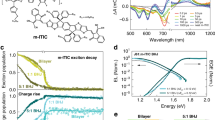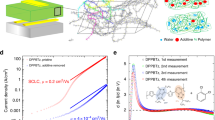Abstract
In 1962, Mark and Helfrich demonstrated that the current in a semiconductor containing traps is reduced by N/Ntr, with N the amount of transport sites, Nt the amount of traps and r a number that depends on the trap energy distribution. For r > 1, the possibility opens that trapping effects can be nearly eliminated when N and Nt are simultaneously reduced. Solution-processed conjugated polymers are an excellent model system to test this hypothesis, because they can be easily diluted by blending them with a high-bandgap semiconductor. We demonstrate that in conjugated polymer blends with 10% active semiconductor and 90% high-bandgap host, the typical strong electron trapping can be effectively eliminated. As a result we were able to fabricate polymer light-emitting diodes with balanced electron and hole transport and reduced non-radiative trap-assisted recombination, leading to a doubling of their efficiency at nearly ten times lower material costs.
This is a preview of subscription content, access via your institution
Access options
Subscribe to this journal
Receive 12 print issues and online access
$259.00 per year
only $21.58 per issue
Buy this article
- Purchase on Springer Link
- Instant access to full article PDF
Prices may be subject to local taxes which are calculated during checkout






Similar content being viewed by others
References
Rose, A. Recombination processes in insulators and semiconductors. Phys. Rev. 97, 322–333 (1955).
Sworakowski, J. On the origin of trapping centres in organic molecular crystals. Mol. Cryst. Liq. Cryst. 11, 1–11 (1970).
Mark, P. & Helfrich, W. Space-charge limited currents in organic crystals. J. Appl. Phys. 33, 205–215 (1962).
Hwang, W. & Kao, K. C. Studies of the theory of single and double injection in solids with a Gaussian trap distribution. Solid-State Electron. 19, 1045–1047 (1976).
Lampert, M. A. Simplified theory of space-charge-limited currents in an insulator with traps. Phys. Rev. 103, 1648–1656 (1956).
Kuik, M. et al. Charge transport and recombination in polymer light-emitting diodes. Adv. Mater. 26, 512–531 (2014).
Bässler, H. Charge transport in disordered organic photoconductors. Phys. Status Solidi 15, 15–56 (1993).
Nicolai, H. T. et al. Unification of trap-limited electron transport in semiconducting polymers. Nature Mater. 11, 882–887 (2012).
Kuik, M., Koster, L. J. A., Wetzelaer, G. A. H. & Blom, P. W. M. Trap-assisted recombination in disordered organic semiconductors. Phys. Rev. Lett. 107, 256805 (2011).
Kuik, M., Koster, L. J. A., Dijkstra, A. G., Wetzelaer, G. A. H. & Blom, P. W. M. Non-radiative recombination losses in polymer light-emitting diodes. Org. Electron. 13, 969–974 (2012).
Campbell, I., Hagler, T., Smith, D. & Ferraris, J. Direct measurement of conjugated polymer electronic excitation energies using metal/polymer/metal structures. Phys. Rev. Lett. 76, 1900–1903 (1996).
Xu, Y. et al. Efficient white-light-emitting diodes based on polymer codoped with two phosphorescent dyes. Appl. Phys. Lett. 87, 193502 (2005).
Campbell, A. J., Bradley, D. D. C. & Antoniadis, H. Quantifying the efficiency of electrodes for positive carrier injection into poly(9,9-dioctylfluorene) and representative copolymers. J. Appl. Phys. 89, 3343–3351 (2001).
Kemerink, M. et al. Relating substitution to single-chain conformation and aggregation in poly(p-phenylene vinylene) films. Nano Lett. 3, 1191–1196 (2003).
Melzer, C., Koop, E. J., Mihailetchi, V. D. & Blom, P. W. M. Hole transport in poly(phenylene vinylene)/methanofullerene bulk-heterojunction solar cells. Adv. Funct. Mater. 14, 865–870 (2004).
Parashchuk, O. D. et al. Acceptor-enhanced local order in conjugated polymer films. J. Phys. Chem. Lett. 4, 1298–1303 (2013).
Noriega, R., Salleo, A. & Spakowitz, A. J. Chain conformations dictate multiscale charge transport phenomena in disordered semiconducting polymers. Proc. Natl Acad. Sci. USA 110, 16315–16320 (2013).
Pasveer, W. et al. Unified description of charge-carrier mobilities in disordered semiconducting polymers. Phys. Rev. Lett. 94, 206601 (2005).
Zhang, Y., de Boer, B. & Blom, P. W. M. Trap-free electron transport in poly(p-phenylene vinylene) by deactivation of traps with n-type doping. Phys. Rev. B 81, 085201 (2010).
Crăciun, N. I. et al. Hysteresis-free electron currents in poly(p-phenylene vinylene) derivatives. J. Appl. Phys. 107, 124504 (2010).
Koster, L. J. A., Mihailetchi, V. D., Ramaker, R. & Blom, P. W. M. Light intensity dependence of open-circuit voltage of polymer: fullerene solar cells. Appl. Phys. Lett. 86, 123509 (2005).
Morteani, A. C. Barrier-free electron–hole capture in polymer blend heterojunction light-emitting diodes. Adv. Mater. 15, 1708–1712 (2003).
Acknowledgements
The authors acknowledge J. Harkema for technical support, B. Noheda and J. M. Varghese for assistance with AFM, and C. Schaefer for his contribution to the calculations of the phase diagrams. D.A. is supported by the Dutch Polymer Institute (DPI), Project No. 733.
Author information
Authors and Affiliations
Contributions
P.W.M.B. proposed and supervised the project. D.A. and A.K. carried out experiments. D.A., G.A.H.W. and N.I.C. analysed the transport data. J.J.M. analysed the phase separation. K.K. carried out and interpreted the CLSM measurements. I.L. carried out and interpreted the TEM measurements. D.A. and P.W.M.B. wrote the manuscript.
Corresponding author
Ethics declarations
Competing interests
The authors declare no competing financial interests.
Supplementary information
Supplementary Information
Supplementary Information (PDF 1965 kb)
Rights and permissions
About this article
Cite this article
Abbaszadeh, D., Kunz, A., Wetzelaer, G. et al. Elimination of charge carrier trapping in diluted semiconductors. Nature Mater 15, 628–633 (2016). https://doi.org/10.1038/nmat4626
Received:
Accepted:
Published:
Issue Date:
DOI: https://doi.org/10.1038/nmat4626
This article is cited by
-
Elimination of charge-carrier trapping by molecular design
Nature Materials (2023)
-
High-brightness all-polymer stretchable LED with charge-trapping dilution
Nature (2022)
-
Filamentary Resistive Switching and Capacitance-Voltage Characteristics of the a-IGZO/TiO2 Memory
Scientific Reports (2020)
-
Interfaces in organic electronics
Nature Reviews Materials (2019)
-
Multivalent anions as universal latent electron donors
Nature (2019)



